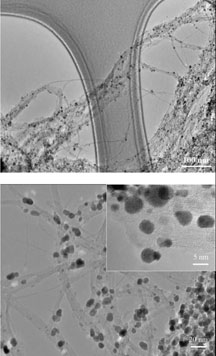| A recent paper by Taylor, et.al, reports the performance of polymer electrolyte membrane (PEM) fuel cell membrane electrode assemblies (MEAs) synthesized using layer-by-layer electrostatic self-assembly techniques that improve Pt utilization by approximately a factor of 4 in comparison to conventional MEA fabrication methods. |
Reviewed by Jeffrey Morse, Ph.D., National Nanomanufacturing Network

These are challenges that may significantly benefit from emerging nanomanufacturing techniques, such as 3-D self-assembly approaches, in order to control materials composition and surface properties at the nanoscale, in particular for disparate materials and integrated structures. A recent paper by Taylor, et.al, (Adv. Funct. Mater. 2008, 18, 3003-3009) reported the performance of polymer electrolyte membrane (PEM) fuel cell membrane electrode assemblies (MEAs) synthesized using layer-by-layer electrostatic self-assembly techniques. In this work, carbon supported Pt electrocatalysts were formed using a supercritical fluid method and a selective heterogeneous nucleation reaction for dispersion of Pt onto single wall carbon nanotubes. This synthesized nanocomposite material was then incorporated into continuous catalyst, gas diffusion, and electrode layers consisting of various polyelectrolytes dispersed with the nanocomposite using layer-by-layer assembly techniques in order to optimize the triple phase boundary over a continuous multi-bilayer configuration.
Experimental results demonstrated that with optimal bilayer composition and thickness (i.e; total number of bilayers), Pt utilization could be improved by approximately a factor of 4 in comparison to conventional MEA fabrication methods. Further improvements may be expected as variations in polyelectrolyte materials, catalyst supports, interfacial properties, and gas diffusion layer materials are explored. At present, the layer-by-layer self-assembly technique represents a methodology for better understanding the kinetics and physics underlying specific materials, structures, and compositions at nanometer scales and features. As this fundamental understanding evolves, these techniques may provide the basis and roadmap for the use of layer-by-layer and other complimentary self-assembly techniques to effectively provide electrocatalytic structures by design at the nanoscale. The benefits will include significant reduction in amounts of precious metals necessary to achieve optimal performance in terms of efficiency and power density, along with more integrated nanocomposite structures that can be readily manufactured at large scale.
Image from Andre D. Taylor, et.al.: Fuel Cell Membrane Electrode Assemblies Fabricated by Layer-by-Layer Electrostatic Self-Assembly Techniques. Advanced Functional Materials. 2008. 18. 3003-3009. Copyright Wiley-VCH Verlag GmbH & Co. GaA. Reproduced with permission.
This work is licensed under a Creative Commons Attribution-NonCommercial-NoDerivs 3.0 Unported.
